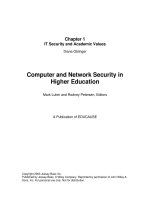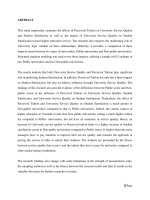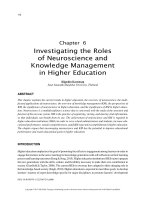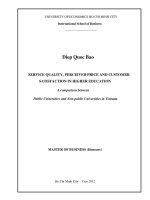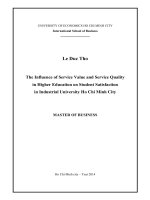Motivation and academic staff in higher education
Bạn đang xem bản rút gọn của tài liệu. Xem và tải ngay bản đầy đủ của tài liệu tại đây (50.14 KB, 7 trang )
Quality Assurance in Education
Emerald Article: Motivation and academic staff in higher education
Jennifer Rowley
Article information:
To cite this document: Jennifer Rowley, (1996),"Motivation and academic staff in higher education", Quality Assurance in
Education, Vol. 4 Iss: 3 pp. 11 - 16
Permanent link to this document:
/>Downloaded on: 04-10-2012
References: This document contains references to 11 other documents
Citations: This document has been cited by 13 other documents
To copy this document:
This document has been downloaded 7305 times since 2005. *
Users who downloaded this Article also downloaded: *
Gordon P. Rabey, (2001),"Motivation is response", Industrial and Commercial Training, Vol. 33 Iss: 1 pp. 26 - 28
/>Jennifer Rowley, (1996),"Motivation of staff in libraries", Library Management, Vol. 17 Iss: 5 pp. 31 - 35
/>Gergana Markova, Cameron Ford, (2011),"Is money the panacea? Rewards for knowledge workers", International Journal of
Productivity and Performance Management, Vol. 60 Iss: 8 pp. 813 - 823
/>
Access to this document was granted through an Emerald subscription provided by UNIVERSITY OF GUELPH
For Authors:
If you would like to write for this, or any other Emerald publication, then please use our Emerald for Authors service.
Information about how to choose which publication to write for and submission guidelines are available for all. Please visit
www.emeraldinsight.com/authors for more information.
About Emerald www.emeraldinsight.com
With over forty years' experience, Emerald Group Publishing is a leading independent publisher of global research with impact in
business, society, public policy and education. In total, Emerald publishes over 275 journals and more than 130 book series, as
well as an extensive range of online products and services. Emerald is both COUNTER 3 and TRANSFER compliant. The organization is
a partner of the Committee on Publication Ethics (COPE) and also works with Portico and the LOCKSS initiative for digital archive
preservation.
*Related content and download information correct at time of download.
Introduction
Motivation and
academic staff in
higher education
The staff of a higher education institution are
a key resource. Academic staff, in particular,
account for a significant component of the
budget of higher education institutions and
have a major role to play in achieving the
objectives of the institution. The performance
of academic staff, both as teachers and
researchers and also as managers, determines,
to a large extent, the quality of the student
experience of higher education and has a
significant impact on student learning and
thereby on the contribution that such institutions can make to society.
Most higher education institutions have an
implicit or explicit mission to offer a high
quality learning experience to all their students. Academic staff manage this learning
experience and are the main interface with
students. Consequently, their motivation is
crucial in determining the quality of this
interface. In addition, research is important
both in revitalizing staff interest in their subject and in keeping their enthusiasm alive, and
in building a research and publishing profile
for the institution. Exceptionally well motivated academic staff can, with appropriate support, build a national and international reputation for themselves and the institution in the
research, publishing and professional areas.
Such a profile may have a significant impact
on the ability of the institution to attract high
calibre students, research funds and consultancy contracts. However, such achievements
depend on an exceptionally high level of
commitment.
Motivation, then, is key in the establishment and further development of quality in
higher education. This article explores some
of the tensions associated with motivation of
teaching staff in higher education. It argues
that formal reward systems are only one tool
which may be used by the effective manager.
The effective manager needs to recognize that
different motivators are appropriate for different staff and that different staff will demonstrate differing inherent levels of motivation in
setting their own targets and striving towards
them. Good management consists of recognizing and working with those individual
differences. Since many teaching staff in
higher education are inherently well motivated and work in an environment where the
development of professional skills and subject
knowledge is the accepted norm, an
Jennifer Rowley
The author
Jennifer Rowley is Head of School of Management and
Social Sciences, Edge Hill University College, Ormskirk, UK.
Abstract
Seeks to identify issues that impact on the motivation of
academic staff in higher education. Argues that the
rational-economic model, the social model, the selfactualizing model and the complex models of motivation
provide a basis for analysing staff motivation as a central
issue in evolving quality cultures. Discusses environmental
factors that impact on motivation which include
approaches to financial rewards, the culture of teaching
and higher education; the diversity of staff experience and
roles, personal autonomy, and organizational structure.
Quality Assurance in Education
Volume 4 · Number 3 · 1996 · pp. 11–16
© MCB University Press · ISSN 0968-4883
11
important component of the manager’s role is
in minimizing dissatisfiers. After exploring the
relationship between quality, culture and
motivation, the article reviews some traditional models of motivation. Despite their longevity these models still offer a useful framework for the consideration of motivation.
Shoolbred (1993) also seek to emphasize the
relationship between quality and culture:
A quality management system … is after all
concerned with how people behave and this
behaviour is made manifest in an organisation’s
climate and culture.
They conclude:
If further and higher education institutions are
going to make serious moves towards effective
quality assurance … they need to be aware how
much the culture may have to change. This may
be highly uncomfortable, for senior management and for the workforce.
Quality, culture and motivation
Quality, and in particular quality assessment
and assurance procedures, have received
much attention in higher education in the
United Kingdom in recent years.
“Quality of education” has been described
as:
In the context of their central theme of culture
and cultural change, they start to explore
some of the mechanisms for harnessing commitment. This article seeks to make a more
thorough analysis of motivation for academic
staff. Admittedly this is only one element of
culture and focuses only on one group of
workers. But the issues for this group are
sufficiently significant for an analysis to be
appropriate. Further work on the cultures and
sub-cultures in a higher education institution
would also provide a more effective backdrop.
The success with which an institution provides
educational environments which enable students effectively to achieve worthwhile learning
goals including appropriate academic standards
(Gordon and Partington, 1993).
Clearly, the student/lecturer interface is
important in determining quality and it is
appropriate to seek to monitor this quality
through appropriate quality assurance
processes. However, this is a very superficial
approach. The real challenge is the enhancement of quality. Different institutions have
started to investigate approaches to quality
enhancement. For example, Hart and Shoolbred (1993) cite Wolverhampton University
as seeking registration under BS 5750 and a
number of other universities as taking the
TQM path, including Aston, South Bank,
Robert Gordons and Wolverhampton. Other
contributions which describe initiatives in this
area include Marchese (1991), Ewell (1991)
and Cornesky (1991). A paper by the Further
Education Unit (1991) offers six criteria for a
quality model:
(1) It seeks to improve the quality of teaching
and learning strategies.
(2) It is flexible.
(3) It harnesses the commitment of all staff.
(4) The learner should be involved.
(5) There must be enhanced working relationships in all functions of the organization.
(6) Requirements can be measured and the
progress can be demonstrated.
Some models of motivation
There are four well-established models of
motivation:
(1) the rational-economic;
(2) the social;
(3) the self-actualizing; and
(4) the complex models.
The first three of these can be regarded as
content models of motivation. Content theories of motivation try to explain the factors
within a person which motivate them.
Although these models were first introduced
some 40 to 50 years ago they are still a useful
framework . The complex model introduces
some aspects of the process theory of motivation. Each of these is described briefly, as a
basis for later discussion.
The rational-economic model
This suggests that people are motivated primarily by economic self-interest, and will act
to maximize their own financial and material
rewards (e.g. Taylor, 1947). People’s motivation then can be controlled largely by offering
or withholding financial rewards. Underlying
this model are the assumptions that people
are passive, are inclined to assert less rather
than more effort, are unwilling to take
This model indicates the central role of
“commitment” or motivation in quality
models. It also recognizes the importance
of treating quality as an organization-wide
issue which covers all functions. Hart and
12
responsibility, and are interested in work for
what they can get out of it financially.
The social model
This can be summarized in the following
terms (e.g. Mayo, 1975):
(1) People at work are motivated primarily by
social needs, such as the need for friendship and acceptance, and their sense of
identity is formed through relationships
with other people.
(2) As a result of increased mechanization
and rationalization, work has lost some of
its meaning, and people increasingly seek
meaning in social relationships at work.
(3) People are more responsive to the pressures of their peer groups at work than to
management controls and incentives.
(4) People respond when management meets
their needs for belonging, acceptance and
sense of identity.
The self-actualizing model
Maslow (e.g. Maslow, 1970) first developed
the idea of self-actualization needs. According
to Maslow, self-actualization is the need a
person has to fulfil his or her capabilities and
potential, that is, his or her desire for growth.
The model further indicates that the following
motivate people:
• Human needs fall into a hierarchy from the
most basic physiological needs to needs for
self-actualization (Maslow, 1970). As the
basic needs are met, energy is released for
the satisfaction of higher needs. Everyone
seeks a sense of meaning and accomplishment in their work (see Figure 1).
• Individuals like to exercise autonomy and
independence and to develop skills.
Figure 1 Maslow’s hierarchy of needs
Selfactualization:
self-development
Ego/esteem: self-esteem,
reputation, standing
Social/affiliation: belonging,
acceptance, friendship
Safety: protection against danger,
threat, deprivation
Physiological: need for food, drink, shelter
• People are primarily self-motivated and
self-controlled.
• There is no inherent conflict between selfactualization and more effective organizational performance. People are happy to
integrate their goals with those of the organization.
Hertzberg conducted a study of accountants
and engineers. Hertzberg et al. (1959) asked
respondents what made them feel good particularly (satisfiers) and bad (dissatisfiers)
about their jobs. Satisfiers or motivators were
closely related to self-actualization needs.
Motivators include the work itself, recognition, advancement and responsibility. Motivators are intrinsic factors directly related to the
job and largely internal to the individual.
Dissatisfiers or hygiene factors relate to
Maslow’s lower level needs. These include
company policy and administration, superannuation, salary, working conditions and interpersonal relations. Hygienes are extrinsic
factors, which the organization largely determines.
Improvement in these dissatisfiers would
remove dissatisfaction, but would not elicit
positive motivation. Positive motivation
comes only from accomplishing a meaningful
and challenging task.
Hertzberg’s study is recognized to have
some limitations. In particular, results for
professional workers may not be applicable to
all groups. In addition, he uses satisfaction
and motivation as interchangeable, and there
is an embedded assumption that increased
satisfaction leads to increased motivation and
this is not always the case. Nevertheless, the
distinction between satisfiers and dissatisfiers
is useful, and the recognition that some factors contribute to positive motivation while
others can only minimize dissatisfaction is
important.
The complex model
Schein (1980) argues that the problem with
each of the preceding models of human
behaviour is their claim to universality and
generality. Schein, instead, sees human nature
as complex, with human needs and motivations varying according to the different circumstances people face, their life experience,
expectations and age. People are motivated to
work when they believe that they can get what
they want from their jobs. This might include
the satisfaction of safety needs, the excitement
13
of doing challenging work, or the ability to set
and achieve goals. Schein emphasizes that
those with responsibility for managing people
need to be sensitive to people’s differing
circumstances and different cultural backgrounds and that strategies for motivating
staff need to accommodate this diversity.
Schein also introduces the concept of a
psychological contract. This contract is essentially a set of expectations on both sides and a
match is important if efforts to improve motivation are likely to be effective. This model
suggests a process of enquiry and negotiation,
where each side makes their expectations
explicit, and some kind of workable agreement is reached. The manager also needs to
recognize that people are not fully aware of
their expectations or most find it difficult to
express them, so the manager needs to be
sensitive and open to signs.
ment in a sector where performance is
rewarded by promotion or increased pay.
Academic staff – environment and
culture
Diversity of staff experience and roles
It is easy to view the academic staff in higher
education as a body, and to seek to introduce
motivation and rewards for the body as a
whole. It is important to recognize that staff
are motivated by different factors, depending
on their length of service in higher education,
their other work experience, their age, their
aspirations with respect to career development and the relative priorities which they
attach to achievement and social factors, such
as their personal life and being accepted as a
team member.
The culture of teaching and higher
education
Higher education is by culture a developmental environment. All staff have a significant
role as teachers, and are subject to the personto-person pressure to perform that is inherent
in this contact. Most staff gain gratification
from working with students and witnessing
the achievement and development of those
students. This is associated with having a
professional pride in their work. It is important for them to be accepted by the students
when they work as a leader and facilitator.
Frustration may develop from dissatisfiers
which prevent staff from doing a good job,
including poor timetable organization, inadequate maintenance of educational equipment,
or too many assorted demands on their time.
This section seeks to draw on some of the
concepts introduced in the last section in
explaining cultural and environmental factors
which impinge on motivation in higher education. Important aspects of the environment
which impinge on the management of motivation include the following.
Financial rewards
Academic staff are appointed to a single salary
scale. Their position on that scale is determined by their qualifications and experience,
and possibly previous salary, at the time of
their appointment. Progression through the
scale is by annual increments. In some institutions additional increments may be awarded
for special achievements, but in others there is
no such scheme. In some subject areas,
notably the professional disciplines, it is
possible for staff to earn additional income by
participation in external, income-generating
activities, but arrangements surrounding
these opportunities vary between institutions.
Promotion is relatively rare, and may reward
many years’ work. In this environment, financial reward is remote from day to day experience, and other sources of motivation are
important. On the other hand some new staff
are on a very low point on the salary scale and
this can act as a dissatisfier, particularly if they
have entered a lecturing post after employ-
Personal autonomy
All staff have significant autonomy over their
own time management, working hours, priorities, development agendas and the relationships they establish with students and other
staff. Indeed, one of the main reasons why
staff select higher education as a career stems
from the opportunity for this level of personal
autonomy. Conflict can arise later when,
having exercised this autonomy which is
inherent in the system, staff seek rewards. Job
descriptions are typically very broad and there
is scope for a mismatch of expectations
between the member of staff and their manager which can be corrected only by effective
communication.
Organizational structure
Different higher education institutions vary in
their organizational structure. Here we are
14
Staff need to appreciate that staffing resources
in specific subject areas are determined by
such criteria and not by the number of teaching or contact hours, as was to some extent
the case in the polytechnic sector in the past.
Communication is necessary to ensure that
staff expectations change with the changes in
the environment.
concerned chiefly with the line management of
academic staff, usually through heads of
department, although clearly the line management of the head of department will determine
their level of motivation and this will impact on
the effectiveness with which they motivate
staff. Most academic staff are grouped either
within departments which often contain 30-50
staff, or into smaller schools of say 15-20 staff.
In both instances the span of control is wide
and it is certainly a challenge for the line manager to maintain effective motivation via personal interaction with all staff.
The financial dimension
The usual strategies for financial motivation
are performance-related pay and promotion.
Such strategies are not usually within the
control of the individual head of department
or line manager and will be controlled by
institutional norms and Funding Council
initiatives. As such, when the opportunity
arises, these strategies can be used by the
individual manager to encourage motivation,
but their intermittent and uncontrollable
nature presents a lot of problems.
Strategies for motivation
In an environment where there is already a
strong development a culture, strategies
which support self-actualization and growth
are strong contenders. These include the
following.
Appraisal and development schemes
These schemes which offer the opportunity
for staff to explore their development needs
with their line manager. Interviews held as
part of this process can be an important area
for developing the psychological contract.
The social factor
Many staff work in the same higher education
institution for many years. It is particularly
important that they are accepted as part of the
social group or team. Most staff have an acute
need to feel that their contribution is worthwhile, appreciated and acknowledged. My
experience is that this need is particularly
evident among those staff who realistically
recognize they have no further worthwhile
career aspirations, yet need reassurance that
their existing skills are still valued in the everchanging environment. This need to continue
to contribute will be a major factor in these
staff accommodating to change.
Opportunities for personal development
Opportunities for personal development
include:
• experience in teaching different groups of
students;
• visiting students on work placement;
• research and publishing activities;
• consultancy;
• study for higher degrees;
• attendance at conferences and workshops;
• management/team leadership experience;
• training in teaching and/or management
skills.
Conclusions
This article has sought to identify some of the
issues which impact on the motivation of
academic staff in higher education. It argues
that such motivation is central to a quality
culture. As higher education institutions
become more sophisticated in their approach
to quality and move on from the current
emphasis on quality assurance to a stronger
focus on quality enhancement, motivation
will become an even more central issue.
Further survey-based research, which
investigates the relative importance of a variety of factors on staff motivation, will offer
additional insights, but will be no substitute
for the development of psychological contracts between staff and their managers.
Managing dissatisfiers
The manager has a significant role in eliminating or reducing dissatisfiers. This is often
achieved through negotiation and allocation
of resources. This must clearly be achieved
within organizational constraints, and where
it is not possible to modify the dissatisfiers,
managers should seek to eliminate their
effects and communicate the constraints. For
example, currently all funding to higher education institutions (for teaching) is based on
student numbers. Most institutions, therefore, allocate staffing resources on this basis.
15
These contracts should accommodate the
view that all staff have differing motivators
and hygiene factors and levels of inherent
motivation in relation to their job. Further
work on the expectations of staff and their
managers and the coincidence of these expectations would be beneficial.
Gordon, G. and Partington, P. (1993), “Quality in higher
education: overview and update”, University Staff
Development Unit (USDU) Briefing Paper 3, USDU,
Sheffield.
References
Marchese, T. (1991), “TQM reaches the academy”,
AHHE – Bulletin, Vol. 44 No. 3, pp. 3-9.
Hart, C. and Shoolbred, M. (1993), “Organisational culture,
rewards and quality in higher education”, Quality
Assurance in Education, Vol. 1 No. 2, pp. 22-9.
Hertzberg, F., Mausner, B. and Snyderman, B.B. (1959), The
Motivation to Work. Wiley, New York,NY.
Cornesky, R. (1991), Implementing Total Quality
Management in Higher Education, Magnar Publications, Madison, WI.
Maslow, A.H. (1970), Motivation and Personality, Harper &
Row, New York, NY.
Mayo, F. (1975), The Social Problems of an Industrial
Civilisation, Routledge & Kegan Paul, London.
Ewell, P.T. (1991), “Assessment and TQM: in search of
convergence”, New Directions for Institutional
Research, Vol. 18 No. 3, pp. 39-52
Schein, E.H. (1980), Organisational Psychology, PrenticeHall, Englewood Cliffs, NJ.
Further Education Unit (1991), Quality Matters: Business
and Industry Quality Models and Further Education,
FEU, London.
Taylor, F.W. (1947), Scientific Management, Harper & Row,
New York, NY.
16


